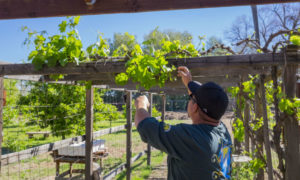
Jacob Butler checks on grapes in the Salt River Pima-Maricopa Indian Community garden. YES!
Credit: Tristan Ahtone.
SALT RIVER PIMA-MARICOPA INDIAN COMMUNITY, Ariz. – Jacob Butler eyed a lemon tree—its bright yellow fruit nestled among thick green leaves and set against the blue Arizona sky—then checked on the tiny pomegranates and grapes in the garden as a black-striped lizard darted into the shade of a mesquite tree. In the distance, downtown Phoenix glittered under the rising sun.
”Our garden is a platform to perpetuate our culture.“
“We try to grow what’s been here for hundreds, if not thousands, of years,” says Butler, the Salt River Pima-Maricopa Indian Community garden coordinator, as he surveyed the land and the plants growing on it. “For the past 13 years we’ve been doing this, so it’s in the minds of the people now.”
Traditionally, Pima and Maricopa tribal members grew lima beans, squash, corn, and other vegetables; used mesquite trees for […]
No Comments
Stephan: Yet another door into the ancient past opens and everything we thought we knew about Neanderthals must be discarded. I think this is extraordinarily exciting research

French Neanderthal cave
Credit: Laboratoire des Sciences du Climat et de l’Environnement 20160048_0006
In February 1990, thanks to a 15-year-old boy named Bruno Kowalsczewski, footsteps echoed through the chambers of Bruniquel Cave for the first time in tens of thousands of years.
The cave sits in France’s scenic Aveyron Valley, but its entrance had long been sealed by an ancient rockslide. Kowalsczewski’s father had detected faint wisps of air emerging from the scree, and the boy spent three years clearing away the rubble. He eventually dug out a tight, thirty-meter-long passage that the thinnest members of the local caving club could squeeze through. They found themselves in a large, roomy corridor. There were animal bones and signs of bear activity, but nothing recent. The floor was pockmarked with pools of water. The walls were punctuated by stalactites (the ones that hang down) and stalagmites (the ones that stick up).
Some 336 meters into the cave, the caver stumbled across
No Comments
Robert Ferris, - NBC News
Stephan: Here is another door opening, beer making in China 5,000 years ago. And good beer at that. We make a grave mistake when we assume that ancient peoples were stupid or unskilled. As the report describes these ancient Chinese used the same techniques used today. Note also the long range trade aspect of this story.
A beer recipe roughly 5,000 years old has been uncovered in China — and researchers call the finding “surprising” because it means people there were importing a critical ingredient from thousands of miles away.
A team of archaeologists from Stanford University, Brigham Young University and two Chinese institutions discovered a cache of ancient brewing equipment — including jugs, pots and funnels — containing remnants of mashed grains and other starches.
The researchers, who were working at the Mijiaya dig site, say their analysis reveals “a surprising beer recipe” containing a grain called broomcorn millet (Panicum miliaceum), barley (Hordeum vulgare), another grain called Job’s tears or Chinese pearl barley (Coix lacrymajobi), and some sort of tuber.
The “recipe” they compiled came from the analysis of those grain residues on the interiors of the vessels. Scholars say the evidence points to a culture that understood advanced brewing techniques that are very similar to modern methods.
“All indications are that ancient peoples, including those at Mijiaya, applied the same principles and techniques as brewers do today,” said Patrick McGovern, an archaeologist at the University of Pennsylvania, who was not involved with the research.
The earliest references to beer in Chinese literature do not pop up until […]
No Comments














